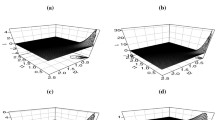Abstract
The robustness of an outlier detection method strongly depends on the weights of observations, i.e., the type of the stochastic model applied (homoscedasticity, heteroscedasticity and heterogeneousness). In this paper, we have investigated how the reliability of the robust methods and tests for outliers changes depending on the weights of the observations in geodetic networks. Furthermore, the contribution of the directions and distances to horizontal control network with regard to reliability are investigated separately. The concept of a breakdown point is used as a global measure of robustness against outliers. The mean success rate (MSR) is found to be a practical tool for confirming the breakdown point. Many different “good” data samples are generated for each network and then deliberately contaminated using a Monte-Carlo simulation. Six robust methods and Baarda’s test are applied to the corrupted samples and the degree of corruption is varied. The performance of each method is measured using both local and global MSRs. Our research shows: (1) The MSRs of Baarda’s test change depending on the strength of the heteroscedasticity, but do not change for trilateration and leveling networks, (2) the global MSRs of robust methods do not differ considerably from the local ones
Similar content being viewed by others
References
Awange JL, Aduol FWO (1999). An evalution of some robust estimation techniques in the estimation of geodetic parameters. Surv Rev 35 (273):146–162
Andrews D (1974). A robust method for multiple linear regression. Technometrics 16:523–531
Baarda W (1968) A testing procedure for use in geodetic networks. Publication on Geodesy. New series 2, no. 5. Netherlands Geodetic Commission, Delft
Barrodale I, Roberts FDK (1974). Solution of an over determined system of equations in L 1-norm. Commun ACM 17:319–320
Benning W (1995). Vergleich dreier Lp-Schaetzer zur Fehlersuche in hybriden Lagenetzen. Zeitschrift fuer Vermessungswesen 12:606–617
Berber M, Hekimoglu S (2001) What is the reliability of robust estimators in networks? In: 1st International Symposium on Robust Statistics and Fuzzy Techniques in Geodesy and GIS March 12–16, ETH, Zurich, pp 61–66
Bickel PJ (1978). Using residuals robustly I: Tests for heteroscedasticity, nonlinearity. Ann Stat 6(2):266–291
Box GEP, Hill WJ (1974). Correcting inhomogeneity of variance with power transformation weighting. Technometrics 16:385–389
Carroll RJ, Ruppert D (1982). Robust estimation in heteroscedastic linear models. Ann Stat 10(2):429–441
Donoho DL, Huber PJ (1983) The notion of breakdown point. In: Bickel PJ, Doksum KA, Hodges JL Jr (eds) A Festschrift for Erich L. Lehmann Wadsworth, Belmont, pp 157–184
Erenoglu RC, Hekimoglu S (2004) Effects of gross errors on reliability and datum in geodetic networks. In: International Symposium on Modern Technologies, Education and Professional Practice in Geodesy and Related Fields, Sofia, 04–05 November 2004, pp 465–470
Fuchs H (1982). Contribution to the adjustment by minimizing the sum of absolute residuals. Manuscr Geod 7:151–207
Gao Y, Krakinwsky EJ, Czompo J (1992). Robust testing procedure for detection of multiple blunders. J Surv Eng 118(1):11–23
Hampel F, Ronchetti E, Rousseeuw P, Stahel W (1986). Robust statistics: the approach based on influence functions. Wiley, New York
Harvey BR (1993). Survey network adjustments by the 1 method. Aust J Geod Photogram Surv 59:39–52
Hekimoglu S (1997). The finite sample breakdown points of the conventional iterative outlier detection procedures. J Surv Eng 123(1):15–31
Hekimoglu S (2005). Do robust methods identify outliers more reliably than conventional tests for outliers? Zeitschrift fuer Vermessungswesen (05/03):174–180
Hekimoglu S, Berber M (2001) Reliability of robust methods in heteroscedastic linear models. IAG 2001, Scientific Assembly, Budapest, 2–7 September 2001, abstract book, p 53
Hekimoglu S, Berber M (2003). Effectiveness of robust methods in heterogeneous linear models. J Geod 76(11–12):706–713
Hekimoglu S, Koch KR (1999) How can reliability of the robust methods be measured? In: Altan MO, Gründig L (eds) Third Turkish–German joint geodetic days, Istanbul, 1–4 June, 1999, pp 179–196
Hekimoglu S, Koch KR (2000). How can reliability of tests for outliers be measured? Allg Vermessungs-Nachr 107(7):247–254
Hekimoglu S, Sanli U (2003). Changing residuals by reweighting one or more observations. Zeitschrift fuer Vermessungswesen (04/03):271–277
Huber PJ (1964). Robust estimation of a location parameter. Ann Math Stat 35:73–101
Huber PJ (1981). Robust statistics. Wiley, New York
Kampmann G (1989). Zur Ausgleichung freier Netze mit der L 1-norm-methode. Allg Vermessungs-Nachr 96:110–118
Koch KR (1996). Robuste Parameterschaetzung. Allg Vermessungs-Nachr 103:1–18
Koch KR (1999). Parameter estimation and hypothesis testing in linear models, 2nd edn. Springer, Berlin Heidelberg New York
Krarup T, Juhl J, Kubik K (1980) Götterdaemmerung over least squares adjustment. In: Procedings 14th congress of int. soc. photogr. Hamburg
Marchall J (2002). L 1-norm pre-analysis measures for geodetic networks. J Geod 76:345–352
Rousseeuw PJ, Leroy AM (1987). Robust regression and outlier detection. Wiley, New York
Pope AJ (1976) The statistics of residuals and the outlier detection of outliers. NOAA Technical Report NOS 65 National Geodetic Survey, Rockville
Wicki F (1999) Robuste Schätzverfahren für die parameterschätzung in geodätischen Netzen. Institut für Geodäsie und Photogrammetrie an der ETH, Zürich, Mitt. Nr. 67
Wilcox RR (1997). Introduction to robust estimation and hypothesis testing. Academic, New York
Xu PL (1989). On the robust estimation with correlated observations. Bull Geod 63:237–252
Xu PL (1993). Consequences of constant parameters and confidence intervals of robust estimation. Boll Geod Sc Aff 52:231–249
Xu PL (2005). Sign-constrained robust least squares, subjective breakdown point and the effect of weights of observations on robustness. J Geod 79:146–159
Yang Y (1994). Robust estimation for dependent observations. Manuscr Geod 19(1):10–17
Yang Y (1999). Robust estimation of geodetic datum transformation. J Geod 73:268–274
Youcai H (1995). On the design of estimators with high breakdown points for outlier identification in triangulation networks. Bull Geod 69:292–299
Author information
Authors and Affiliations
Corresponding author
Rights and permissions
About this article
Cite this article
Hekimoglu, S., Erenoglu, R.C. Effect of heteroscedasticity and heterogeneousness on outlier detection for geodetic networks. J Geod 81, 137–148 (2007). https://doi.org/10.1007/s00190-006-0095-z
Received:
Accepted:
Published:
Issue Date:
DOI: https://doi.org/10.1007/s00190-006-0095-z




